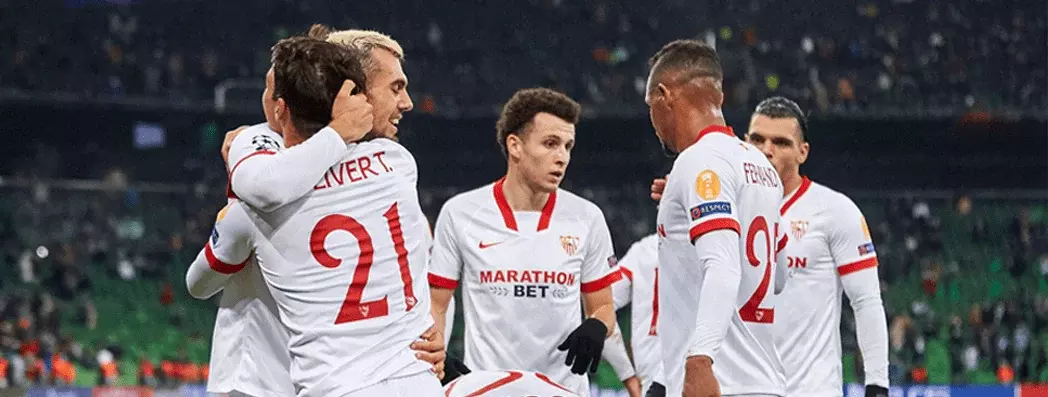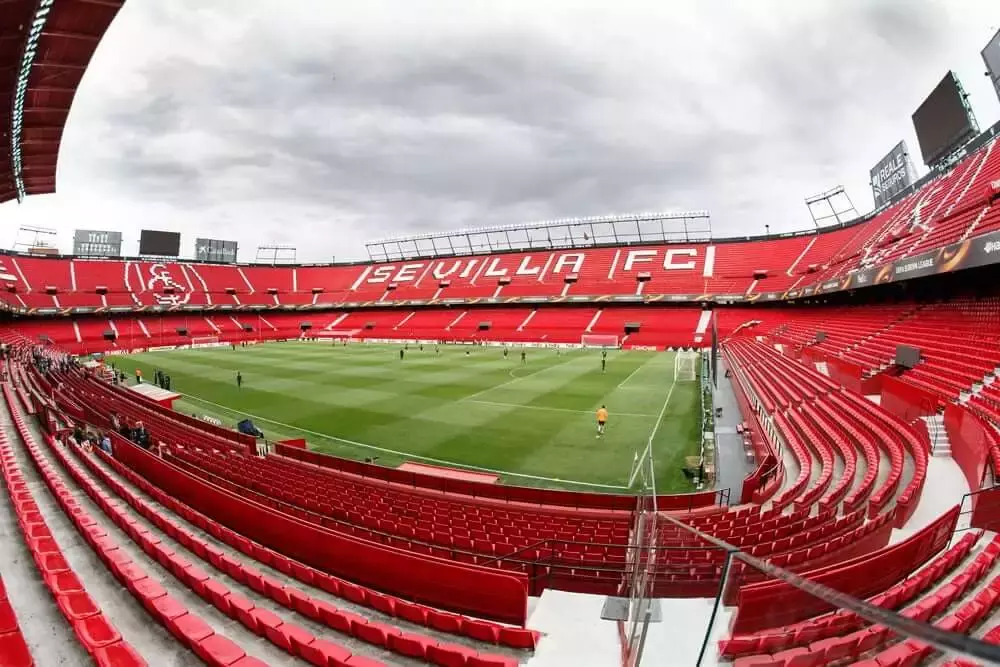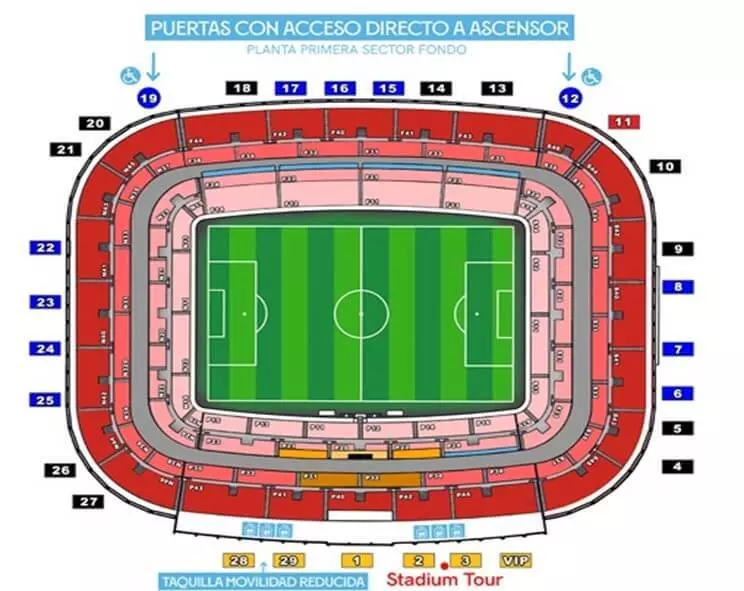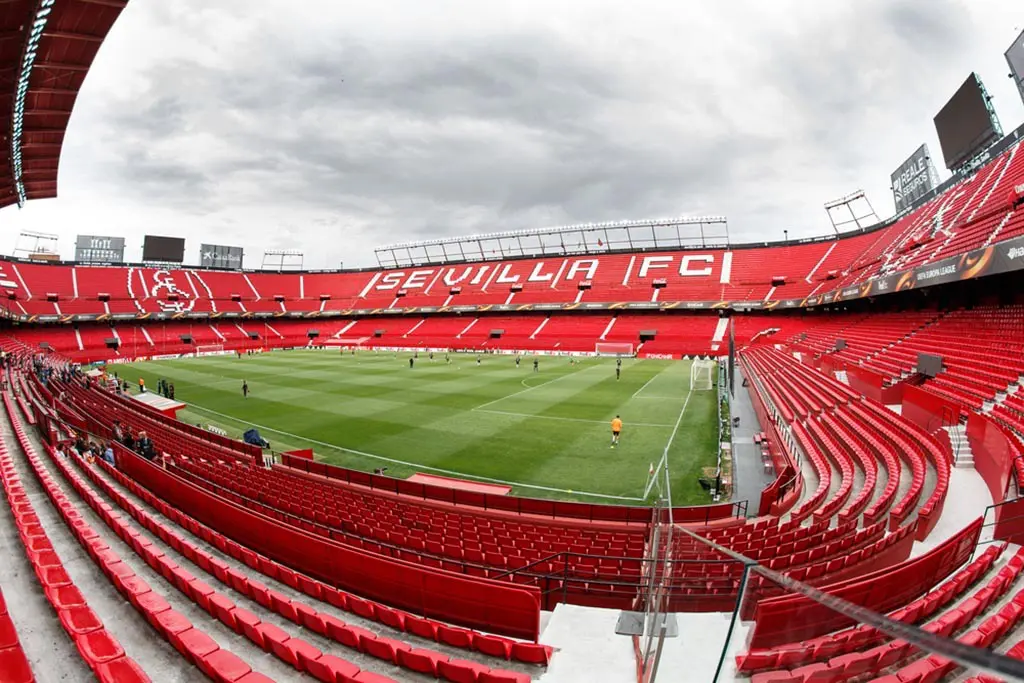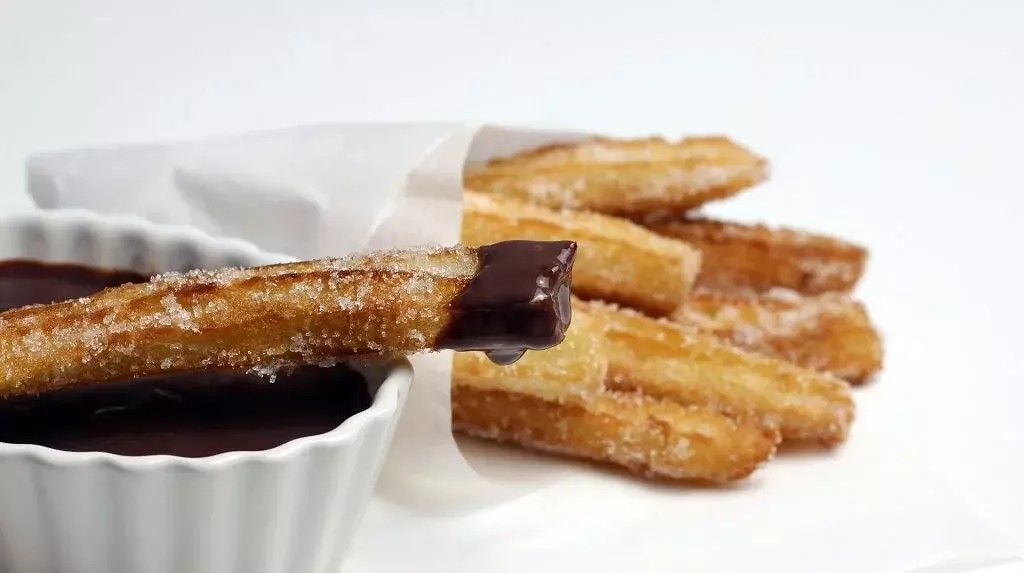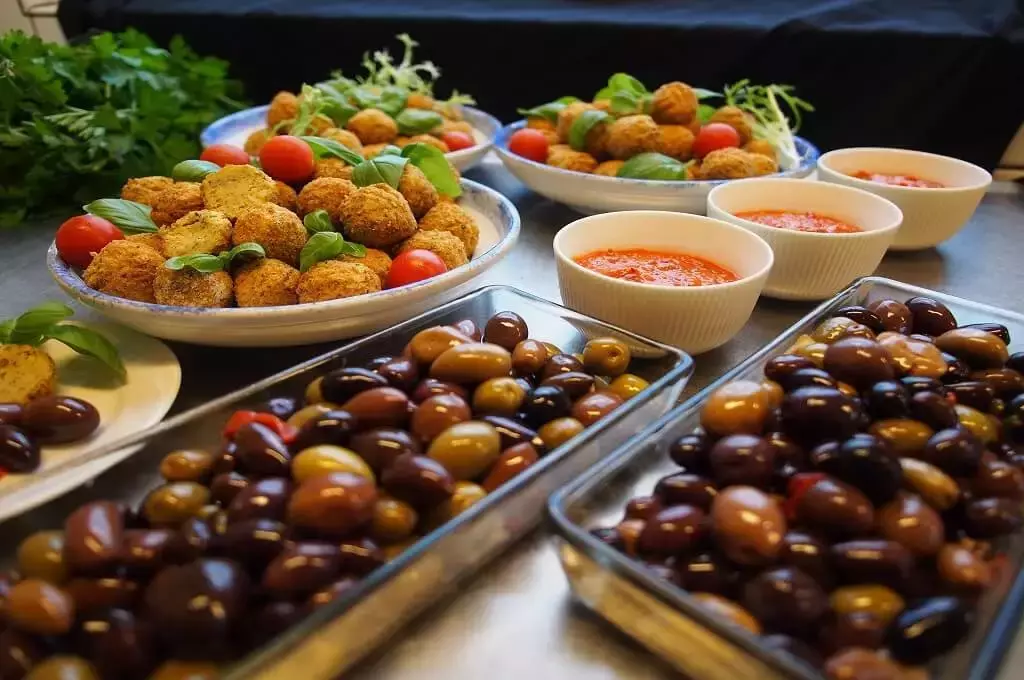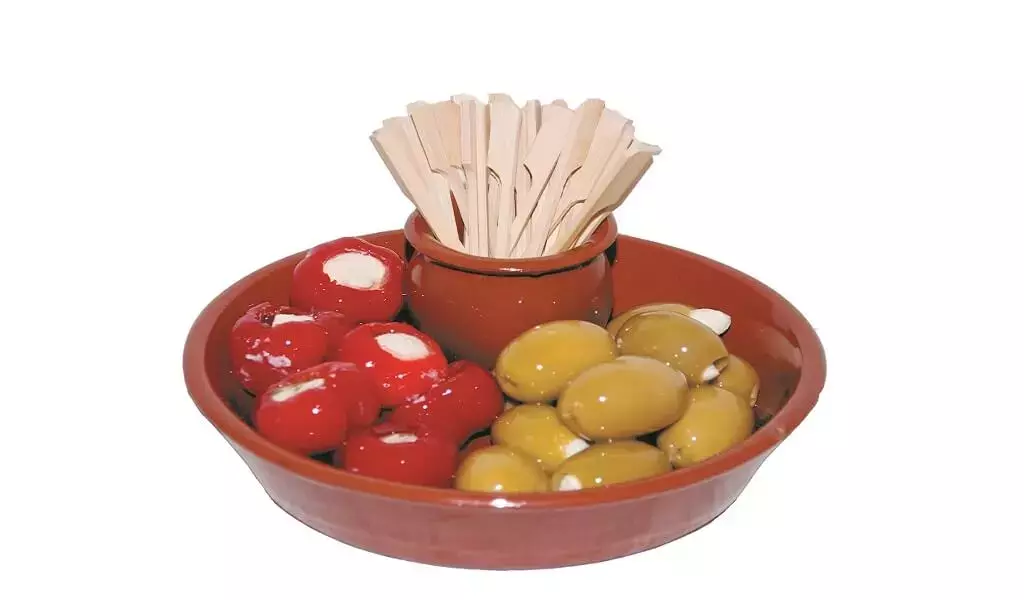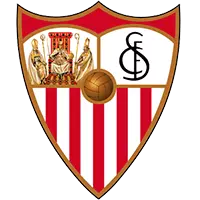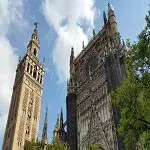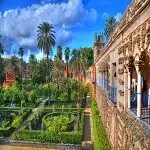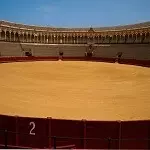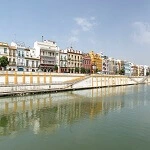Tip! Make sure you have a valid ticket. + Read more
- Paper or e-tickets
- A carefree experience
Sevilla FC
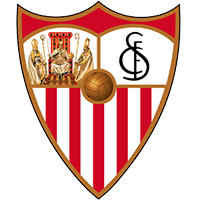
Football trip
Sevilla FC

Tip! Make sure you have a valid ticket. + Read more
- Paper or e-tickets
- A carefree experience
Tip! Make sure you have a valid ticket. + Read more


Tip! Make sure you have a valid ticket. + Read more
Easily book your complete football trip to Sevilla FC. Choose which match, hotel & seat all in one place. No booking fees.
Seville is not Europe’s hottest city and the home of exhilarating flamenco music for nothing. Sevilla FC matches are also all about heat and passion. The club’s stadium, in bright red and white colours, is one of the most intimidating arenas in Europe. Especially when the whole stadium sings the ‘Himno Centenario’ just before the starting signal, the sweltering atmosphere can be felt in your entire body.
Besides the exciting atmosphere, you are also assured of a great view of the field and high-level football. Sevilla FC is not the uncrowned king of the Europa League for nothing. In the past 15 years, the club has won the coveted European Cup no less than six times! You can see them all in the club museum.
The city itself, with its impressive cathedral, palaces and gardens, often described as Europe’s open-air museum, is another place you will not easily forget. This all-inclusive trip is one of the best European football trips imaginable.
We have picked out the best tips to make sure you get the most out of your football trip to Seville. From practical information about the Estadio Ramón Sánchez Pizjuán to suggestions for exploring Seville.
Until 1958, Sevilla played in the old Nervión stadium, with a capacity of 23,000. However, under the legendary president Ramón Sánchez Pizjuán, Sevilla became so successful (winning the cup three times and the league title in 1946) that a larger home base was needed in the 1950s. On a piece of land bought by the president, a new stadium with 70,000 seats was planned.
But in 1956, a few weeks before construction was to start, Pizjuán died suddenly. The new stadium, which opened in 1958, was named in his honour. Due to many problems with the construction, the stadium cost the club much more than calculated, so the capacity was reduced to 53,000 places. Only after 28 years, in 1974, was the construction completed with a total of 77,000 places.
During the 1982 World Cup in Spain, two matches were played in the stadium, including the semi-final between Germany and France (with the infamous Schumacher – Battiston incident). In the 1990s, the capacity dropped to 43,000 after UEFA banned standing room in stadiums. Currently, the stadium has a capacity of 43,883.
The atmospheric stadium has a special status not only among Sevilla fans. Spain’s national team played 25 international matches there, remaining unbeaten (20 wins, 5 draws).
It is not only the inside of the stadium that looks great. On the outside, a number of beautiful mosaics can be seen. On the occasion of the 1982 World Cup, the club crest was displayed, along with the logos of 60 other clubs that have played in the stadium. There are also pictures of club trophies, club legends and a tribute to Antonio Puerta, the midfielder who died after suffering cardiac arrest during a match at the Estadio Pizjuán in 2007.
The Ramón Sánchez Pizjuán Stadium is located in the middle of the Nervión district, less than three kilometres from the centre of Seville. It is therefore perfectly doable to go to the stadium on foot; it will take you half an hour at most and you will certainly not be the only one. If you prefer not to exert yourself too much, then the metro, bus or taxi are good alternatives.
By Metro
Seville has three metro lines, which are mainly intended to reach the outskirts of the city. However, the stadium can also be easily reached by metro line 1 (green).
In the centre of Seville, get on at the Puerta Jerez (near the Royal Palace) or Prado de San Sebastian stops. After a four-minute ride you get off at the Nervión stop, or one stop further on at Gran Plaza. From both stations it is a five-minute walk to the stadium. The ride will cost you less than €2.
Sevilla Stadium Address Details
Estadio Ramón Sánchez Pizjuán
Calle Sevilla Fútbol Club
41005 Seville
By Bus
There are a number of bus lines in the centre of Seville that stop close to the stadium: B3, C1, C2, 5, 22, 23, 24, 27, 28, 29, 32 and EA (the Airport Shuttle). Get off at the Eduardo Dato stop or the Luis de Morales stop. These stations are located a few hundred metres from the stadium.
By Taxi
A taxi ride in Seville is a lot cheaper than in most other countries. Official taxis are white with a diagonal yellow line and always drive with a meter. You can just stop the taxi on the street; if the taxi is available, a green light on the roof will light up. From the city centre, you should pay no more than €10 for a ride to the stadium.
The sides of the stadium are:
Your football trip is not complete without a look behind the scenes with the Sevilla FC Stadium Tour. In 2018, Sevilla FC opened a new museum, which is six times larger than before.
You start the Tour in the museum, where the history of the club is shown in four large halls. You’ll also find all the shirts worn over the years, and of course the many trophies. Nowhere else in the world will you find a trophy cabinet with no less than six Europa League cups. You then visit the VIP boxes and VIP Suite of the president, the press room, changing rooms, players’ tunnel, the pitch and finally the Club Store. All in all, the tour lasts about 75 minutes.
Normally, it is possible to take the tour on Saturdays from 11am to 9pm and on Sundays from 11am to 3pm. On match days there is no tour, as well as the day before and after a European Cup match.
Be sure to book in advance through the website. Time slots are used and at some times the tour can also be booked on weekdays.
Since Seville attracts tourists from all over the world, you will never have to search long for a restaurant or bar. The area around Seville FC’s home ground is also teeming with eateries. Right next to the stadium is the Nervión Plaza shopping centre, where you will find several places to eat. Also in the streets around the stadium are plenty of tapas bars and pubs. We have picked some favourites for you.
100 Montaditos is a Spanish sandwich chain with branches all over the country. On Av. Eduardo Dato, 400 metres from the stadium, you will also find one. Motaditos are mini baguettes served here with up to 100 different fillings. From savoury to sweet, there is nothing you can’t think of. On Wednesdays and Sundays, almost all dishes cost just €1. The beer is always cold, as the beer mugs come straight from the freezer.
At Sacrificio 3, about ten minutes’ walk from the stadium, there is a tapas restaurant that you should not miss. It is praised for its friendly service, excellent food and modest prices. In addition to the standard tapas, Arabic and Andalusian cuisine is tastefully mixed. The menu is also available in English and each dish mentions whether it is gluten-free or unsuitable for people with certain allergies. If you are in Seville, make sure you don’t miss this restaurant…
For the best sports bar you really have to be in the city centre. One of the most popular bars is The Merchant, at Calle Canalejas 12. This Irish pub shows all the sporting events on multiple screens. There is a wide range of beers, at reasonable prices. The kitchen provides fresh burgers, homemade fries, chicken wings, sandwiches and salads.
Sevilla FC was founded in 1890, although the first official match was not played until 1914. The club achieved great success in the 30s and 40s: in 1935, 1939 and 1948 they won the Spanish Cup, and in 1946 the first (and only) national championship. To be able to compete with superpower Real Madrid for a long time, the Estadio Pizjuán was built, but due to many setbacks, the construction costs rose to an astronomical level. As a result, there was no money left to play a significant role in the league. The club was relegated in 1968. In 1997 and 2000, Sevilla also relegated to the Segunda División.
Only in the new millennium did the club return to the top, mainly thanks to the breakthrough of a large number of talents. In 2006 Sevilla won both the UEFA Cup and the European Supercup. A year later it also won the UEFA Cup. Sevilla FC then made history by winning the (now called Europa League) Cup in 2014, 2015 and 2016 as well. In 2020, the Cup was even won for a sixth time; Inter were beaten 3-2 in the final. In La Liga, Sevilla has always been in the top four in recent years, and is secretly dreaming of a second league title. A strong asset is the frenzied public, which makes for a very intimidating atmosphere.
Sevilla FC’s big rival is, of course, city rival Betis Sevilla. This club was founded in 1907 by renegade members of Sevilla FC. The social background also played a role. Sevilla FC was especially loved by the middle class, while Betis was known as a leftist working-class club. Although this no longer plays a role, and Sevilla FC has considerably surpassed its city rival in terms of performance, the derby is still one of the most charged matches in the Spanish league.
The club song – the aforementioned Himno Centenario – was composed in 2005 by local musician El Arrebato and immediately reached the number one position in the Spanish charts. At every match, both home and away, the fans sing the song at the top of their voices. New players are expected to sing the song as soon as possible.
Sevilla’s current logo has existed since 1995, but it has hardly changed since 1921. The triangular shield, in the shape of a heart, has a golden border. The three different images of the logo are held together by a leather ball. This is the football that was used at the 1938 World Cup in France (the so-called Allen model). Top left is the city emblem of Seville. On the upper right is the club logo, which has been in existence since 1908: the initials SFC (Sevilla Fútbol Club).
Opinions are divided about the red and white stripes at the bottom of the logo. Some claim that the colours are inspired by the flag that King Ferdinand of Castile carried when he recaptured the city from the Moors in 1248. But the most likely reason is that the club initially planned to play in red and white stripes (see also Sevilla’s jersey).
Sevilla have always worn the same jersey: a white shirt (with red accents), white trousers and black socks. At the beginning of the 20th century, white was the most common colour of football shirts, as it was the best available and cheapest option. Nevertheless, in the early years, people considered playing in the red and white striped shirt of Sunderland. This was to happen in a friendly against Huelva in 1909. Because the ordered shirts arrived too late, Sevilla decided to play in white. After that, the board decided that white would remain the permanent colour. When the ordered Sunderland shirts arrived, it was decided to keep this shirt as the second jersey. That is also the reason why the club’s away jersey is still red.
What to do in Seville?
Seville is not known as an open-air museum for nothing. Greeks, Romans, Moors, Vikings; they have all left their traces in the city. You stumble over the historical monuments, gardens, parks, churches and palaces. In addition, Seville is a city like you imagine Spain to be: flamenco music, blossoming orange trees, excellent tapas and, of course, bright sunshine (Seville is the hottest city in Europe). We have listed a number of sights that you should not miss.
This 15th-century church is the largest Gothic cathedral in the world, and the largest church building in Europe after St Peter’s (Rome) and St Paul’s Cathedral (London). The 105-metre bell tower has become the symbol of the city. This tower was originally the minaret of a mosque. In the 12th century, the largest mosque in the city stood on this spot. The interior contains a large number of unique works of art. The tomb of Christopher Columbus is also located here.
The entrance fee to the cathedral and the ascent of the bell tower is €10. It is also possible to take an audio tour or join a guided tour. It is highly recommended to book online in advance. You will save 10% and avoid the long queue at the ticket office.
Real Alcázar de Sevilla is not a newly founded football club, but the Royal Palace of Seville, and also the most visited attraction of the city. We recommend that you do not miss out on this amazing complex. However, if you are unlucky enough to have the Spanish king in town, he will sleep here, and the complex will be closed. You will find a collection of impressive palaces, built in the unique Mudejar style (a mixture of Christian and Muslim art, only found in Spain). There are also extensive gardens with ponds, palms and orange trees. As no more than 750 people are allowed in at any one time, advance booking is a must. A ticket costs €14.50, which also gives access to a number of other museums. Retirees and students can enter for €7, but must show a passport or European student card.
We will certainly not recommend you view bullfighting in Spain. However, we do make an exception for a ground hop to Plaza de Toros, the largest and most important bullring in Spain. This monumental building, located in the harbour district of El Arenal, took no less than 120 years to build, from 1761 to 1881. The square and the entrance with its baroque façade are particularly beautiful. The main arena, with around 12,000 seats, is also worth a look. There is also a museum showing the history of bullfighting. It is open Wednesday to Sunday from 10 am to 4 pm. You pay €10 for a guided tour of the museum and the bullring. The tour is in Spanish and English.
About a 20-minute walk from the cathedral, on the other side of the river, you will find the characteristic working-class quarter of Triana, known as the birthplace of flamenco. You’ll enjoy wandering through the narrow streets of this former sailor and gypsy quarter and will find remarkably few tourists. Visit the Mercado de Triana, a market hall where the locals stock up on vegetables, meat and fish. And be sure to try a few eateries here. Along the river you will find a large number of restaurants and bars.
